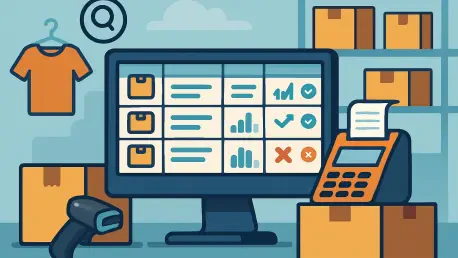For small retail businesses, managing inventory effectively can be the difference between thriving and merely surviving in a competitive market, and many owners still grapple with outdated methods like manual spreadsheets. These often lead to costly errors, stockouts, and frustrated customers who can’t get what they need when they need it. The right inventory software offers a lifeline, transforming these challenges into opportunities by streamlining operations, cutting costs, and supporting growth. This article explores ten leading inventory software solutions tailored specifically for small retailers, highlighting tools that can enhance efficiency and provide a solid foundation for scaling. From startups running a single boutique to businesses managing multiple locations, these platforms cater to diverse needs with features like real-time tracking and seamless integrations. By adopting such technology, small retailers can ditch the guesswork, save valuable time, and make informed decisions that keep them ahead of the curve. This guide serves as a roadmap for those ready to modernize, breaking down the landscape of inventory management software and showcasing what drives small businesses to upgrade their systems for better control and profitability.
The Urgent Need for Modern Inventory Tools
Small retail businesses often find themselves bogged down by traditional inventory tracking methods that are not only time-consuming but also prone to human error. A staggering 80% of brands still rely on outdated systems like manual logs or basic spreadsheets, which can result in significant inefficiencies and stock discrepancies. These inefficiencies translate into lost sales when products are unavailable or excess costs when overstocking occurs. Inventory software addresses these pain points directly by automating processes that would otherwise drain resources. Beyond just organizing stock, these tools provide clarity into what’s selling and what’s not, enabling retailers to focus on strategy rather than firefighting daily inventory issues. The shift to digital solutions is no longer optional but a critical step for staying competitive in a fast-paced retail environment where customer expectations continue to rise. Embracing such technology means small businesses can redirect their energy toward growth and customer satisfaction rather than getting stuck in operational quagmires.
The financial impact of adopting inventory software is another compelling reason for small retailers to make the switch. Studies show that tools like Zoho Inventory and Lightspeed can reduce administrative workloads by up to 30%, freeing up hours that can be better spent on other business priorities. Additionally, carrying costs—often a hidden burden for small retailers—can be slashed by as much as 20% through smarter stock management. These savings are not just numbers on a balance sheet; they represent real opportunities to reinvest in marketing, product development, or staff training. Moreover, improved order fulfillment accuracy, boosted by 20-30% with platforms like Square and Cin7, directly enhances customer trust and loyalty. When orders are correct and delivered on time, small retailers build a reputation for reliability, which is invaluable in a market where word-of-mouth can make or break a business. The urgency to upgrade is clear—modern inventory tools are a gateway to both operational stability and long-term success.
Essential Features That Drive Efficiency
When selecting inventory software, real-time tracking stands out as a non-negotiable feature for small retailers aiming to maintain control over their stock levels. Platforms such as Zoho Inventory and Square excel in providing instant updates on inventory status, ensuring that businesses are never caught off guard by sudden stockouts or overstocking issues. This capability allows for immediate responses to customer demand, preventing lost sales and reducing the frustration of managing discrepancies manually. Real-time data also supports better planning, as retailers can see trends unfold as they happen, adjusting orders or promotions accordingly. For small businesses with limited storage space or tight budgets, this precision is a game-changer, helping to optimize every square foot and dollar spent on inventory. The ability to monitor stock at a glance transforms inventory management from a reactive chore into a proactive strategy that aligns with business goals.
Another critical feature to prioritize is integration with existing systems, a need echoed by 97% of software buyers who value seamless connectivity. Tools like SalesBinder and Zoho Inventory offer robust links to popular e-commerce platforms such as Shopify and accounting software like QuickBooks, creating a unified operational flow. This integration eliminates the risk of data silos, where information is scattered across disconnected tools, leading to errors and inefficiencies. For small retailers, especially those selling across multiple channels like physical stores and online marketplaces, having a single source of truth for inventory data is invaluable. It ensures consistency in financial reporting and stock updates, reducing manual data entry and the errors that come with it. By connecting inventory software with point-of-sale systems and other tools, small businesses can streamline workflows, saving time and minimizing disruptions to daily operations.
Balancing Cost and Accessibility
Affordability remains a top concern for small retailers, many of whom operate on razor-thin margins that leave little room for expensive technology investments. Fortunately, several leading inventory software solutions address this by offering free or low-cost entry points. Square and Sortly, for instance, provide free plans with essential features, making them ideal for startups or businesses just dipping their toes into digital inventory management. These no-cost options allow retailers to test the waters without financial risk, ensuring that even the smallest operations can access tools that improve efficiency. Such accessibility democratizes technology for small businesses, leveling the playing field against larger competitors who may have deeper pockets. The availability of free tiers reflects an industry-wide recognition of the budget constraints faced by small retailers and a commitment to supporting their growth from the ground up.
For those ready to invest a bit more, affordable upgrades and tiered pricing plans offer flexibility without breaking the bank. Sortly’s premium plans start at a modest $29 per month, while SalesBinder provides free plans with unlimited items and locations, catering to slightly larger needs without a steep price jump. On the higher end, platforms like Cin7 and Lightspeed range from $69 to over $300 monthly, delivering advanced features for businesses prepared to scale. This spectrum of pricing ensures that small retailers can find a solution that matches their current financial situation while leaving room for future growth. Additionally, cloud-based platforms and mobile apps, as seen with Zoho Inventory and Sortly, enhance accessibility by allowing inventory management on the go, even offline in some cases. This flexibility is crucial for small retailers who often juggle multiple roles and locations, ensuring they stay connected to their operations no matter the circumstances.
Catering to Diverse Retail Environments
Inventory software isn’t a one-size-fits-all solution, and the best tools recognize the varied needs across different retail sectors. Lightspeed, for example, is designed to support a broad spectrum of retailers, from small boutiques to online stores and even multi-location businesses, with features tailored for each environment. Its adaptability makes it a strong choice for retailers who may start small but have ambitions to expand, offering tools for inventory tracking across various channels without the need for multiple systems. This kind of versatility ensures that businesses don’t have to overhaul their software every time they pivot or grow, saving both time and resources. For small retailers in niche markets, finding a platform that aligns with their specific operational style can significantly boost efficiency and customer satisfaction, as it addresses pain points unique to their industry.
Specialized needs are also met by tools like Clover, which focuses on restaurants with portable POS systems and features for managing both online and in-store orders seamlessly. This specificity allows restaurant owners to handle inventory challenges like perishable goods and fluctuating demand with precision, something generic software might overlook. Similarly, Cin7 offers robust support for complex setups, including multi-warehouse management and over 100 customizable reports, catering to retailers with intricate supply chains. For small businesses in sectors like food service or fashion, where inventory needs can vary widely, having software designed with their unique demands in mind is a critical advantage. Matching the right tool to the specific retail environment ensures that inventory management becomes a tailored solution rather than a generic fix, maximizing its impact on daily operations.
Harnessing Data for Strategic Advantage
One of the most transformative aspects of inventory software lies in its ability to empower small retailers with data-driven insights that were once out of reach. Features like demand forecasting and low-stock alerts, available in platforms such as Cin7 and Lightspeed, enable businesses to anticipate customer needs and maintain optimal stock levels. Cin7’s advanced analytics, for instance, provide predictive insights that help avoid overstocking, while Lightspeed’s sales trend reports can reduce missed sales opportunities by up to 25%. This proactive approach to inventory management means retailers can stay ahead of market shifts, ensuring products are available when demand spikes. For small businesses, where every sale counts, leveraging data to make informed decisions can be the difference between meeting quarterly goals and falling short, turning inventory from a liability into a strategic asset.
Ease of use is equally important in ensuring that these powerful data tools are accessible to small retailers who may lack technical expertise. Software like SalesBinder and Sortly prioritizes intuitive interfaces and responsive customer support, minimizing the learning curve and allowing business owners to focus on running their operations rather than struggling with complex systems. When software is user-friendly, it becomes a practical tool rather than a barrier, enabling even the least tech-savvy retailers to harness data effectively. Additionally, features like Lightspeed’s 14-day free trial allow businesses to test the waters before committing, ensuring the chosen platform fits their workflow. By combining powerful analytics with approachable design, inventory software ensures that small retailers can not only access critical data but also act on it with confidence and minimal friction.
Making the Right Choice for Long-Term Success
Selecting the ideal inventory software begins with a clear understanding of a business’s unique needs, including budget limitations, operational scope, and future growth plans. For startups or single-location retailers, the simplicity and affordability of tools like Square might be the perfect starting point, offering basic features without overwhelming complexity. On the other hand, businesses with plans to expand across multiple locations or sales channels might find greater value in the depth and scalability of platforms like Cin7, which can handle more intricate inventory demands. This initial assessment of priorities ensures that the chosen software aligns with current realities while providing a foundation for future ambitions. Small retailers must weigh factors like cost against functionality to avoid overpaying for features they don’t yet need or underinvesting in a tool that can’t support growth.
Exploring trial periods and hands-on features can further refine the decision-making process, helping retailers determine what truly works for their operations. Lightspeed’s free trial or Clover’s portable POS system offers practical ways to evaluate software in real-world scenarios, ensuring compatibility with daily workflows before a full commitment is made. The goal is to find a tool that not only addresses immediate inventory challenges but also positions the business for sustained success in a competitive retail landscape. By carefully matching software capabilities to specific needs—whether it’s real-time tracking, integration, or data insights—small retailers can transform inventory management into a strength that drives efficiency and profitability. The journey to modernizing operations starts with this critical choice, setting the stage for streamlined processes and enhanced customer experiences that build lasting loyalty.









